While some people love the sound of a revving engine at full throttle, others savor the peace and quiet of a nearly silent motor while gliding across the water. If you want a break from the noise of weekday traffic by relaxing on tranquil boating days, and if you get excited about renewable energy that goes easy on the earth, then electric power is for you. As more vehicles use electric power, the prevalence of gas-free engines is spreading from the highways to the water. We’ve gathered some electric options currently on the market for when you’re ready to dive into clean, quiet energy.
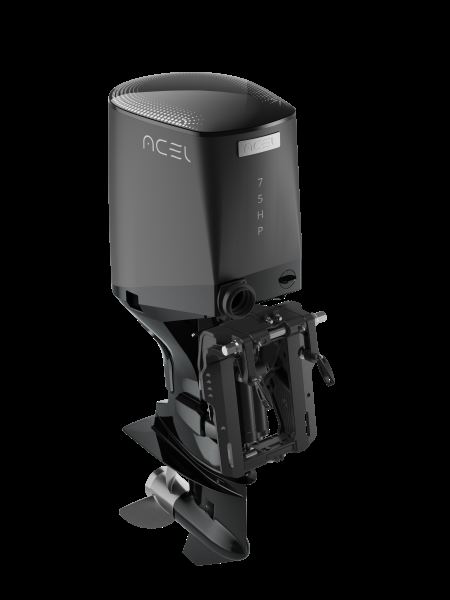 ACEL Power
ACEL Power
Designing futuristic technology from the ground up, ACEL Power is leaving the combustion-engine behind with instant acceleration, silent operation, and advanced battery technology.
“We are changing the boat’s entire infrastructure, not just the engine. We call it intelligently powered, where everything will be digitized using components of AI and data collection to improve the experience of the boater,” company CEO Anthony Liu said.
With 50hp and 75hp engines on the market and 150hp and 250hp ready for their mass-produced rollout this fall, ACEL Power is ready to deliver high horsepower electric systems through distributors and dealers around the world.
The standard ACEL pack includes the entire power system with seamlessly integrated components, including outboard motor, customizable battery system, intelligent power supply, digital throttle, smart key, and an on board computer with an intuitive touch screen and a smart charger that works in a regular wall outlet. Optional upgraded chargers can recharge the batteries in one hour with enough power supply.
The waterproof batteries use LFP chemistry, which guards against overheating and overcharging. As a hybrid system, they can be charged with an on board generator for unlimited boating range. ACEL outboards can go 31 miles (50 km) at full throttle and much farther at slower speeds. The batteries are also stackable, so “you can always add on and double the range,” Anthony said.
When considering the cost of electric power, vice president Natasha Chawla says that “while the front-loaded cost for the entire electric system is higher, the reality is that traditional motors have long term costs with gas and maintenance. So over time, electric power is actually comparable to gas-powered outboards, or even lower.” www.acelpower.com
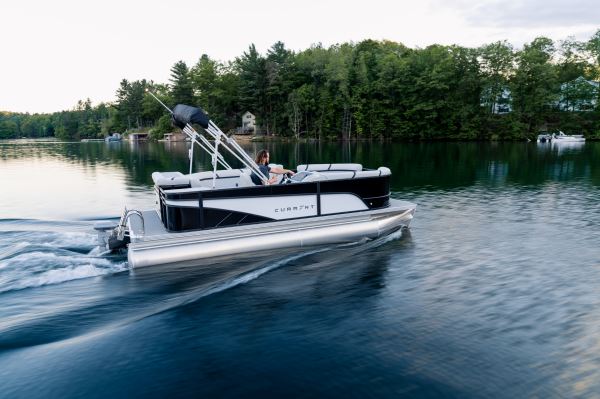 Crest Current
Crest Current
Cruise quietly through your favorite waterways on efficient and clean power, all while spending less hassle with outboard maintenance and more time making memories on the water. The Crest Current is a high-quality pontoon with all of the amenities you love along with the electric system of an ePropulsion Navy 3.0 Evo motor with E175 battery.
Well-equipped with all of the luxurious and signature features of a great pontoon, the Crest Current boasts a spacious and comfortable captain’s chair, a roll-out Bimini top, USB ports, and wireless phone chargers. You’ll find the same quality styling in the fencing and interior options to match. LED lighting edging the boat will help you dock and take off safely and in style. With superior comfort and the highest quality construction, this electric pontoon boat delivers thoughtful and functional features.
“The Current is a direct reflection of Crest Pontoon Boats’ continual efforts to push the boundaries of innovation in order to deliver a superior boating experience for everyone regardless of potential lake limitations and personal preferences,” said Patrick May, president of Crest Pontoon Boats.
Equipped with its own unique helm and gauges to monitor speed and battery life, the 20-foot Current has a specially constructed deck to support the model’s two, 25-inch aluminum tubes, seating for up to 10 passengers, and L-shaped sunpad layout. Providing efficient and clean power, the Current is ready to make waves in either salt water or fresh water. www.crestpontoonboats.com
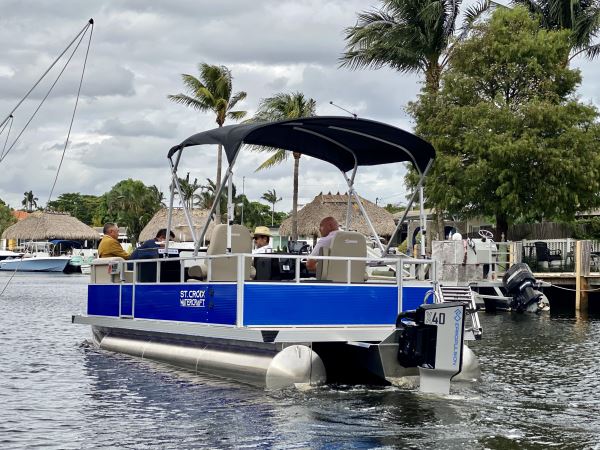 ePropulsion
ePropulsion
For the past ten years, ePropulsion has been on a mission to provide high quality electric motor solutions for boats. Tom Watson, the company’s president said, “Environmental concerns and the ability to boat in a quiet and peaceful way have grown significantly in the boating community.”
And companies such as ePropulsion are here to meet the demand. By developing fully integrated systems that include motors, batteries, controls, and charging, ePropulsion offers excellent marine electric propulsion solutions. Their outboard options range from 1.5-60hp gas outboard equivalents as well as full lineups of POD and inboard models. Typically, the batteries can be recharged in 4 hours.
Customers’ most common question is often, “How fast will I go?” Tom explained that the answer is dependent on weather conditions, the efficiency of the hull and the load in the boat. “Although ePropulsion models will plane specific boats, most are best suited for displacement speeds of 3 to 6 miles per hour,” he said.
ePropulsion typically provides an hour of full speed runtime; however, most boats perform well at 1/3 throttle, giving 3 to 4 hours of boating, fishing, or transportation enjoyment. To alleviate a boat owner's concerns that they might run out of battery while on the water, ePropulsion engines include time and range tools to ensure that people make it back to port. Tom said, “It is actually no different than monitoring your remaining fuel in a gas powered boat.” www.epropulsion.com
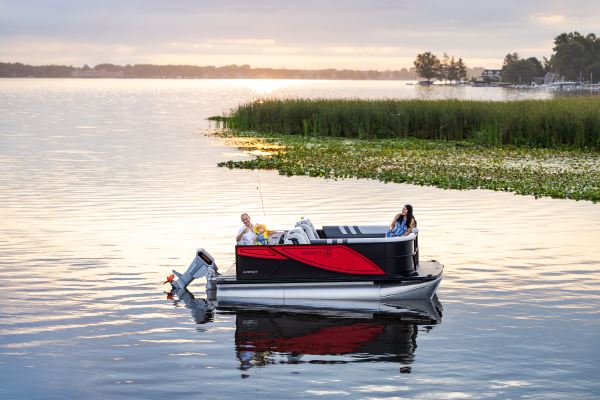 Godfrey Mighty G
Godfrey Mighty G
Ready to open up their options to electric power, Godfrey designed the Mighty G, a small 15-foot, 7-inch long pontoon that can be paired with either a gas or electric outboard and is designed to be efficient in either configuration. Initially, they anticipated five percent of purchase volume would be electric, but were pleasantly surprised when nearly 10 percent of customers chose to go with renewable energy.
“We knew we wanted to design a small boat that could serve many uses, and we wanted to provide something that has electric power for restricted bodies of water,” said Melissa Ramey, Godfrey’s marketing manager. “And its best feature is the usefulness of such a diminutive boat and how many people it can carry—up to seven!” she said.
Battery recharging for the Mighty G is incredibly efficient; recharging from completely empty to fully charged can be done in less than 8 hours on a single extension cord from a normal 120 VAC 15 amp outlet.
Currently, max speeds for the Cruise Torqeedo electric outboards that the Mighty G is paired with stay under 10 mph, and Melissa explained the most common misconception people have when comparing slower electric-powered boat speeds to the high speeds possible in electric cars.
“Many people don’t understand the relationship with the drag that the water has on a boat versus the air on an electric car. That is why an electric car can cruise at highway speeds with minimal power, but a boat at only half its rated speed is taking an immense amount of power due to all that hydrodynamic drag,” she said.
Though electric propulsion remains expensive, Godfrey knows that as with any new technology, it will only improve from here. As the versatility and convenience of electric power continues to grow, the Mighty G is an excellent place to start. www.godfreypontoonboats.com
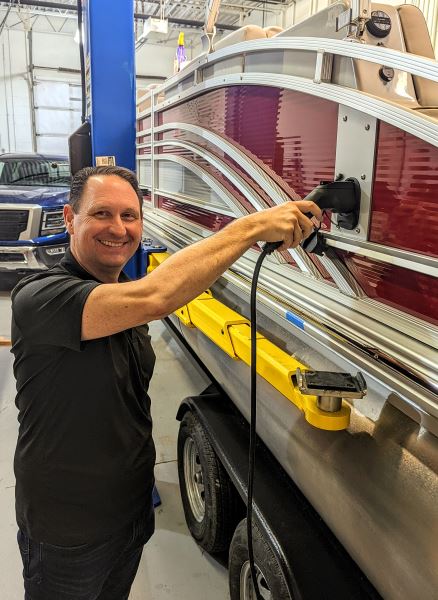 Hercules Electric Marine
Hercules Electric Marine
Designed to revolutionize recreational boating, the electric drive system from Hercules Electric Marine can be configured to fit almost any boat and will take up only a fraction of the space of a combustion motor. Their advanced electric propulsion technology offers superior performance to gas engines and can survive harsh environments. With the efficient Hercules e-Drive system, you can create a custom solution to fit your current or new boat and say goodbye to hauling gas cans to the dock.
Utilizing powerful permanent magnet motors, all digital drive-by-wire controls, and up to 94kWh of battery storage for all day power, Hercules marine packages include on board chargers to charge your craft using 110V, 220V outlets or auto industry fast chargers. This system also acts as a 12V battery to power all your stereos, marine electronics, and accessories all day long. Integrated solar charging systems are coming soon.
With customizable power levels, the user can set the power from 10hp up to 250hp in order to reach their optimal range or to meet horsepower or speed restrictions that are on some waterways. With the patent-pending pontoon edrive system, batteries can be installed directly in the tube and will work in dual or triple pontoon options. www.hercules-marine.com
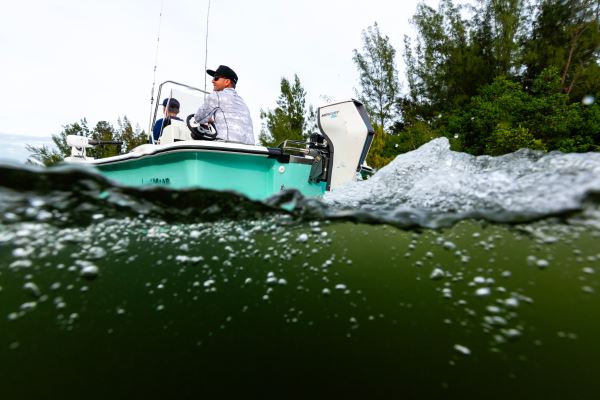 Mercury Avator
Mercury Avator
Whether it’s fishing, cruising with friends, or spending time boating across a lake, the Mercury Avator is an outboard designed for the same recreational water activities as any other motor. Engineered to provide an incredibly smooth and quiet boating experience, the Avator is perfect for enjoying nature. With no fumes and no gas cans to carry, you will have a quiet, easy way to access new waters and open up gasoline engine-restricted waterways to more activities.
Built to be a primary propulsion system, the Avator is not a dedicated trolling motor, though it can certainly work as one in the same way any gas-powered motor can. With the capability to be optimized for efficient performance, how you run the outboard will determine the distance you can travel and the length of time you can spend boating.
Modular and swappable battery systems can help you obtain the right amount of power to meet your needs; work with your dealer to decide what’s right for you.
As with all electric motors, Avator outboards can be run at lower speeds to extend runtime. How far you can go and how long the system will run varies based on your boat, load, and water conditions. Right now the lineup of low-voltage Avator electric outboards includes the 7.5e, 20e and 35e models, with the 75e and 110e soon to be available. www.mercurymarine.com
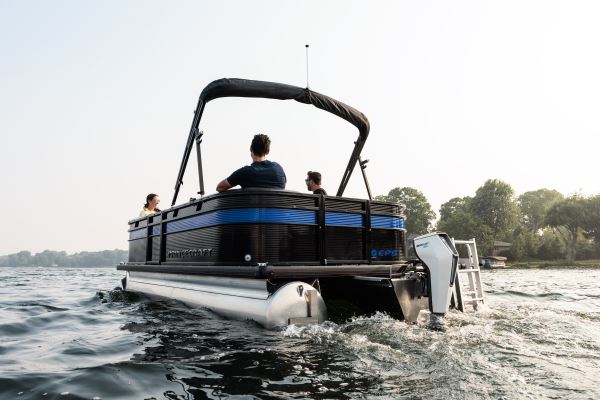 Princecraft Brio E-19
Princecraft Brio E-19
By introducing the electric-powered Brio line in 2011, Princecraft made the decision to invest in renewable power early on because they saw that it would become an ever-growing trend. Beginning to produce boats that run on electric engines over a decade ago also gave Princecraft an edge in being able to adapt their product designs as the market has evolved.
Based in Quebec, Canada, Princecraft sees a high demand in electric power resulting from the area’s many restrictions on gasoline engines. “Because of these restrictions on gas engines and limits of 9.9hp, many people modify their pontoons by adding a trolling motor even though that is not the way to properly adapt a pontoon,” Director of Marketing Jean-Philippe Martin-Dubois said.
Therefore, the Brio E-19 is not simply a regular pontoon that can be paired with an electric engine such as an Avator or Torqeedo. “Everything about the Brio is electric!” Jean-Philippe said. “It has lighter furniture, a lighter console, and less structure since that pontoon will never have the same stress compared to a similarly-sized pontoon carrying a heavy 90hp or a 115hp. This is really the essence behind the Brio, having a boat design around the electric propulsion,” he said.
Cruising times and battery life will vary depending on the wind and water conditions, but the autonomy increases significantly with a second battery bank. The Avator engines both run on two batteries but you can have up to four batteries in the boat, doubling your autonomy.
Misconceptions about having enough power to return to the dock have changed drastically from when electric outboards were first introduced. Now people are familiar with charging and they know they’ll have enough power to enjoy their time on the water. While the speed of an electric engine can’t match what’s attainable with gasoline powered engines, Jean-Philippe said, “We must understand that electric boats are not fast at this time, but the speed will come. You do have more than enough power to cruise around the lake, and it feels so cool not to hear the engine running or feel its vibration.” www.princecraft.com
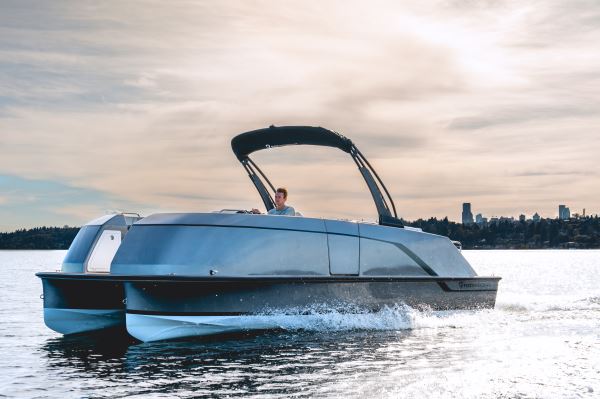 Pure Watercraft
Pure Watercraft
Aware of the growing interest in electric boating, Pure Watercraft designed and built the Pure Pontoon, a futuristic-looking and luxurious pontoon powered by single or twin electric outboards. The motors run so quietly that idling noise is eliminated and normal speaking volume can be used at all times, making it easy to converse with friends and family.
The boat’s 66 kWh battery pack is built into the boat itself, just like you’d find in electric cars. Recharging can be done on either a standard 110-120V outlet, or a larger 208-240V connection; a complete recharge can be done in around 9 hours. Arne Landboe from Pure Watercraft said, “Runtime will depend on how fast you're driving, but anywhere from 35 to 100 miles is achievable on a single charge, which we often see is plenty for a full day of boating.” By selling directly to customers, Pure Watercraft can make sure the propulsion system gives boaters their desired range capabilities.
The outboards’ low profile frees up the entire stern of the boat for a large rear swim deck, perfect for lounging in the sun or diving into the water. Climb aboard easily with the telescoping swim ladder, enjoy music on the premium JBL sound system with Bluetooth connection, and readily view speed, battery percentage, and remaining range with the informative throttle display that adjusts in real time.
Although many people have misconceptions that electric motors pose high fire or explosion risks, Pure Watercraft assures consumers that their systems have never experienced either, despite being tested under extreme conditions. With strict safety standards in place, electric batteries and motors likely pose the lowest risk of all forms of marine propulsion.
About switching from gas to electric power, Arne said, “The key to getting people to change to a new way of doing something is to build an offering which is better than the old way. In our case, eliminating noise, fumes, fluids and off-season maintenance gets rid of much of the extra work that goes into boat ownership and instead lets boaters spend more of their time being on the water.” www.purewatercraft.com
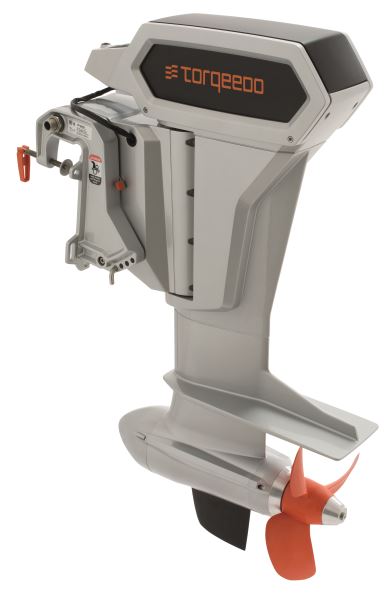 Torqeedo Cruise
Torqeedo Cruise
Building electric drive systems for boats since 2005, Torqeedo electric motors offer a quieter and smoother ride compared to their gas counterparts, enabling passengers to enjoy a much more tranquil boating experience.
Because Torqeedo’s electric systems are both modular and scalable, they can power a vessel weighing up to 12 tons, making them an excellent choice for pontoons. Explaining the many benefits of electric power, Torqeedo’s marketing manager Tess Smallridge said, “Torqeedo motors produce zero emissions, reducing pollution in water bodies and minimizing the ecological footprint of boating activities. With fewer moving parts and no need for oil changes, electric propulsion systems by Torqeedo offer a hassle-free boating experience, saving both time and money in the long run.”
The most popular option for pontoon boats are Torqeedo’s Cruise motors offering 6hp to 25hp, and are best matched with 24-volt and 48-volt lithium batteries. Range and runtime will vary based on how fast you travel and the size of the boat, the motor, and the battery bank. Purchasing a battery bank for two to four hours of runtime is common; a Torqeedo fast charger can charge a 48V power battery in about 1.5 hours. However, for most pontoon boat owners, overnight charging is sufficient.
For those interested in truly renewable power, solar panels pair perfectly with pontoons and can directly charge the Torqeedo Cruise. “The Brio by Princecraft is a solar pontoon boat that makes its own power—free, green, and always ready to go,” Tess said. www.torqeedo.com
.JPEG_600.jpg) Vision Marine Technologies
Vision Marine Technologies
Ready to electrify the waters, Vision Marine has created the P PowerPack, an electric outboard powertrain to revolutionize pontoon boating. Culminating three years of dedicated development, integration, and testing, the powerpack is seamlessly compatible with pontoon boats and has undergone over a thousand hours of sea trials in Florida’s challenging saltwater environment.
Representing a groundbreaking leap in boating technology, the powerpack offers easy installation and can be speedily installed within a few hours. The ease of use and ease of installation will help make the transition to electric boating practical and accessible while also being innovative.
The game-changer in this marine propulsion system is the E-Motion 180E Powertrain, which delivers a robust 180hp thanks to its high-tech marine-designed motor, complete with multisensor captors and an independent cooling system. Using the highest quality standards in the industry, the powertrain is guaranteed for safe marine use.
Featuring an on board charging system, the powerpack allows convenient charging from any shore outlet, whether in or out of the water. Vision Marine is building technology to help pontoon manufacturers embrace electrification so they can not only move forward, but also move forward sustainably. www.visionmarinetechnologies.com

